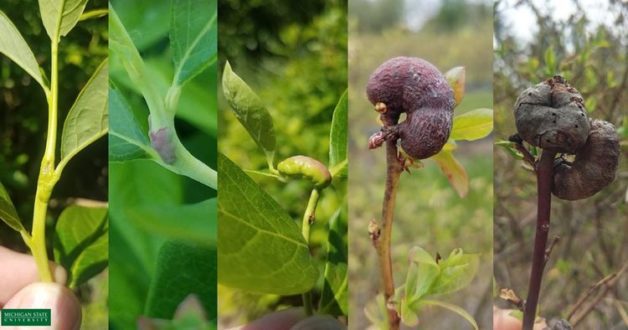Apr 1, 2021Most effective spray options identified for blueberry stem gall wasp
Blueberry stem gall wasp is a sporadic pest of blueberries that is native to eastern North America. This tiny wasp lays its eggs into young shoots in the spring, typically during bloom, and in susceptible cultivars of highbush blueberry the stem swells around the egg-laying site to create a gall.
A full description of the life cycle of this pest and a list of susceptible and resistant cultivars is provided in a fact sheet available in English and Spanish published by Michigan State University Extension.
In 2020, our team at Michigan State University compared various insecticide treatments for controlling this pest. All applications were made with a backpack sprayer at an equivalent of 80 gallons of water per acre, and with a penetrating adjuvant. Previous trials have demonstrated that it is essential to use a high volume of water to thoroughly cover the foliage and stems, plus the penetrating adjuvant also helps greatly to ensure that the materials applied reach the inside of the stems where the eggs and larvae are developing. Wetcit, R-11 or JMS stylet oil have all been used for this in recent trials, but there are many other penetrating adjuvants on the market.
In 2020, we conducted spray trials at a Jersey cultivar field in west Michigan. The trial compared various programs comprised of two sprays made during the period after bloom, mostly with one made as soon as the honeybees were removed from the field and the other a week later. In these trials, the most effective treatments were Lannate followed by Imidan a week later. We also tested a tank mix of these two insecticides and found that this has very similar efficacy, so you could save a trip through the fields this way.
Either of these programs would be highly effective for fruitworm control in this period of the season, but they are also highly toxic to bees plus you may want to retain these uses for later in the season for spotted wing Drosophila (SWD) control. So, we have also been evaluating newer insecticides for this pest.
An application of Verdepryn followed by another application of Verdepryn one week later was also found to be highly effective. This insecticide is a diamide insecticide registered for use in blueberry that now also has a 2ee label for this use. Note that this insecticide will also provide excellent control of fruitworms during this time of the season.
We also compared timings for Movento, an insecticide that has a unique ability to move inside the plant’s tissues. This seems to be helping with its effectiveness since the application of Movento to bushes after bloom has also greatly reduced gall infestation. In a comparison of different timings of application, we found that Movento applied seven days after bloom ended reduced gall density and size on the bushes. This single application could be combined with other treatments before hand (see above) because Movento does not have activity on fruitworms.
The approach of using Movento once also is borne out by some large-scale demonstration trials where control was compared in plots receiving one application or two, and the second application did not provide greater control at that site. To get the full effect from using Movento, it is critical that a penetrating adjuvant and high volume be used with this insecticide since it needs to get into the plant tissues to work well. Note that Movento does not have gall wasp on the label (yet), but it is also labelled for controlling aphids and gall midge that are active in the same period of the season.
In addition to the replicated field trials described above, some growers have been testing these treatments, or some different combinations of the insecticides, at their farms. In fields where the density of galls is lower, we observed excellent control from one application of Movento. The combination of Lannate and Imidan described above is also reported to have worked very well at some commercial farms. Finally, in 2020 we also found significant reduction in plots where the grower had combined Lannate and Movento, along with the Wetcit adjuvant, applied in high volume.
Given the timing of gall wasp control treatments, it is important to make sure bloom is finished, honey bee colonies have been removed from the field and to prevent pesticide drift onto any blooming habitat.
This research was funded by Michigan Blueberry Commission, Michigan State Horticultural Society, Michigan Department of Agriculture and Rural Development and U.S. Department of Agriculture.
– Rufus Isaacs, Michigan State University, Department of Entomology
Figure 1. Progression of developing gall caused by the blueberry stem gall wasp in a susceptible highbush blueberry cultivar. From left: initial swelling a week after egglaying, initial gall development, shoot bending, mature gall in late summer, wasp emergence holes in following spring.















